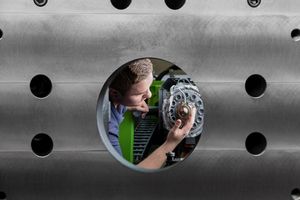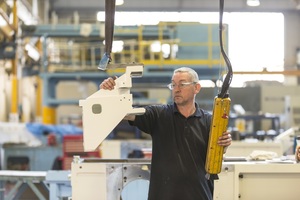

|
Edward Lowton
Editor |


|
| Home> | Efficient Maintenance | >Industry 4.0 | >Improving maintenance processes through MSIN partnerships |
Improving maintenance processes through MSIN partnerships
29 August 2023
IF THE pandemic taught us anything, it was the value of collaboration. Driven by necessity, businesses joined forces to remarkable effect. The way the manufacturing community came together without delay to produce critical supplies for the NHS revealed a lot about the agility and innovation within the industry. New partnerships were forged and have endured.

Three years on, we face a different set of challenges, including rising energy prices, supply chain disruption and labour shortages, as well as the demand to drive for Net Zero. What's needed is innovation and collaboration and this is where the Made Smarter Innovation Network (MSIN) is helping.
Launched three years ago as part of the £300m Manufacturing Made Smarter Challenge by UK Research and Innovation (UKRI) through Innovate UK, the government’s innovation agency, MSIN was tasked with creating a vibrant community of digital technology providers, developers, and manufacturers. These partnerships are supported to fast-track ideas and digital innovation using advanced technologies such as artificial intelligence, machine learning and data analytics, additive manufacturing, robotics and automation, virtual reality and augmented reality, Industrial Internet of Things (IIoT) and Blockchain.
It was inspired by the 2017 Made Smarter UK review that found the positive impact of faster innovation and adoption of industrial digital technologies could be worth as much as £455bn to UK manufacturing over the next decade, increase manufacturing sector growth between 1.5 and 3 percent per annum, and create an estimated 175,000 new jobs.
Innovate UK is delivering the five-year programme and has supported hundreds of partnerships to overcome challenges including net zero, supply chain, continuous improvement, new product development, flexible manufacturing, and production systems.
One area that has forged successful outcomes is in the prediction and diagnosis of machine health, which has never been as vital to manufacturers as it is now.
Case study 1 - Tribosonics and ENGEL
Tribosonics, a sensor innovator based in Sheffield, and ENGEL, a global leader in the manufacture of plastics processing machines, are a success story of collaboration.
ENGEL designs and manufactures machines that make anything from toothbrushes to lighting systems on cars and from toys to packaging for beverages.
A challenge emerged with its Inject 4.0 portfolio, which captures weight, flow and vibration measurements within its machines and enables its customers to make real-time data-driven decisions to increase machine availability and productivity.
It was struggling to measure the wear on the plasticising feed screw, a key component in the process which influences the product's quality, because it is fully enclosed and cannot be accessed from the outside.
This meant ENGEL’s customers were faced with a difficult choice in maintaining these screws, both resulting in downtime and cost implications. Preventative maintenance, to manually check the screw wear, could put the machine out of action for two days, whereas reactive maintenance meant they would only react when the wear impacted process or product quality.
Avoiding downtime
They wanted to develop a solution to observe the screw barrel without disassembling it and avoid downtime but were unable to find a sensing solution that could withstand the extreme temperatures produced in the polymer process.
Through Made Smarter Innovation, ENGEL was put in touch with Tribosonics who set a goal of developing a monitoring system that a technician could set up and use within minutes to accurately evaluate a screw’s condition and determine if it needs replacing.
The solution was a real-time monitoring system which uses an ultrasonic high temperature transducer on the outside of the machine to send a wave to a pulser receiver to detect and record changes to the screw. These real-time measurements are uploaded to a digital platform, automatically analysed against previous data, and reported to the customer.
The innovation has transformed the maintenance cycle for ENGEL’s customers, reducing the time it previously took to ascertain the screw wear from two days to one hour, saving significant costs from unnecessary or unplanned maintenance, while increasing machine uptime, productivity and energy efficiency, and reducing the waste from producing scrap components.
Upskilling employees
Meanwhile, machine operators previously involved in the manual stripping and measuring process will be upskilled in intelligence-based decision-making to monitor and plan maintenance.
ENGEL can now offer the value-added service to new customers and retrofit older machines, offering further opportunity to maximise revenues.
For Tribosonics, the collaboration has resulted in patented sensor technology it can now look to apply in other sectors, and further cements its position as a high-tech scale-up at the forefront of Industry 4.0 using innovation to drive digital transformation and tackle some of the industry's key challenges.
Research shows 3% of the world's total energy consumption is used to remanufacture worn parts and spare equipment due to wear and wear-related failures. By addressing friction and wear, there is the potential to reduce energy consumption by 40% in the long term, which on a global scale amounts to savings of 1.4% of GDP, 8.7% of total energy consumption, and a reduction of CO2 emissions by up to 3,140 metric tons.
The innovative collaboration between Tribosonics and ENGEL demonstrates how important it is to work together to find the best solutions which can benefit industry and the planet.
Case study 2 - CarnaudMetalbox Engineering and T-DAB
Another great example of using emerging technologies to embrace the benefits of predictive maintenance is the partnership between CarnaudMetalbox Engineering (CMbE), a manufacturer of high-performance metal forming and finishing machinery for beverage cans, based in West Yorkshire, and T-DAB, a London-based artificial intelligence and machine learning solutions provider.
Consumer demands for more sustainable, infinitely recyclable metal packaging in the wake of the single use plastic pollution crisis is driving a need for faster, more productive, more efficient and more reliable metal can forming machines. Simultaneously, these manufacturers are losing experienced operators who can identify problems with these machines to retirement.
CMbE identified the need to support its customers by introducing process monitoring to improve machine uptime to cope with capacity demands, and help mitigate the skills shortages. They partnered with T-DAB to develop an innovative process monitoring solution.
Addressing low frequency vibrations
The project, dubbed Canvolution, focussed on CMbE’s Bodymaker, which can make around 350 beverage cans per minute. But the harsh low frequency vibrations produced by the machines combined with aggressive metal forming lubricant coolants, present a hostile environment for applying typical sensors or measurement equipment.
Working with long-term partner Computer Controller Solutions, specialists in high-speed data acquisition systems, CMbE solved the challenge of capturing the 1TB of data generated by each of its machines per week. But it needed a partner who could provide an architecture to securely transmit, store and analyse that data, to perform some machine learning on that live data in order to predict process change, and to visualise the data it had collected locally and remotely.
The solution also needed to overcome some key challenges including the complexity and expense of moving such an abundance of IoT data from individual machines to a centralised place for machine learning and AI processing, ensuring reliable internet connectivity, as well as data privacy and security.
The key to the solution was to turn the problem on its head. Rather than move all the data to where the ML or AI model is for training, T-DAB proposed moving the model to where the data is generated.
It managed this using an OctaiPipe distributed AI platform and a catalogue of ML pipelines. It means that the data collected from the machine is processed through automated ML models close to the source that can make the predictions. That insight is then communicated to the operator or triggers an automated function of the machine.
Meanwhile, this processed data is batched up and transmitted to the cloud which hosts a specialised time series database called influxdb. There it is able to perform model visualisation and execute model training before being deployed back to the edge.
Protection against connectivity issues
Having the models at the edge means that the machine can continue providing data even if it loses connectivity to the cloud.
These critical elements allow CMbE to have intelligent Bodymakers where the machine learning can run independently on individual devices, but at the same time data can be leveraged across all its devices for model training up in the cloud.
Data analytics is giving CMbE advanced understanding of the can-forming process which will lead to the ability to offer recommendations for optimisation of machine set-up, to ensure the Bodymaker functions more reliably and consistently.
Data dashboards give operators real-time visualisation of the machine health and process health, giving some indication of when some intervention is needed.
By introducing elements of predictive maintenance, operators know earlier when to replace machine tooling, therefore optimising its usage, when to service machine alignment which avoids unnecessary work, and alert them to imminent process failure, which reduces operator response time and triggers reventative action to reduce downtime.
CMbE’s first foray into machine learning, process monitoring and predictive maintenance has been a step change in our understanding of the can-forming process and the potential insights offer a range of benefits to its business and customers.
What’s next for Made Smarter Innovation
These are just two examples of the power of innovation through collaboration, the driver behind the broader Made Smarter Innovation challenge, which also extends to academic partnerships, leveraging R&D opportunities with new research centres, digital accelerators and innovation hubs.
We are aiming to harness the power of this ecosystem to deliver a modern, connected, resilient and flexible, significantly more productive, and environmentally sustainable UK manufacturing sector and a vibrant technology sector that enables that transformation.
In the last three years we’ve accomplished a great deal. The team at Innovate UK have engaged significant parts of manufacturing, but there is much more to do to really harness the full power of UK manufacturing.
Our ambitions are to increase UK GVA by £2.3bn, create thousands of highly skilled jobs, raise productivity by 30%, create a 4.5% decrease in carbon emissions, create a 25% decrease in manufacturing waste, and allow the UK to shape the future of manufacturing.
With two years of the challenge to go, Innovate UK backed by UKRI will continue to engage further, accelerating and expanding innovation through collaboration for the people-led digital manufacturing future we need.
Made Smarter Innovation Network
- Helping SME manufacturers realise the smart factory dream
- Why North East manufacturers should consider the Made Smarter programme
- Emerging technologies used to navigate COVID-19
- Cake-making engineer inspires a new generation of women in industry
- Digital spare parts: innovation to solve supply chain woes
- South East manufacturers kickstart digital transformation with Made Smarter leadership programme
- Made Smarter survey reveals need for manufacturers to digitalise
- Made Smarter creates 60 digital manufacturing leaders
- Helping SME manufacturers make the most of cobots
- Cardboard cutout manufacturer invests in AI and automation
- Technology and Open Standard data enabling smart maintenance
- Broadband sensors: Pinpointing leaks in compressed air systems
- Mechanised welding, cutting and Industry 4.0
- Tomorrow’s tech is here today
- Investment in infrastructure, innovation and people
- Getting to 4.0 – one hard-won gain at a time
- Digital transformation in the chemical industry: White paper
- Digital industry around the world
- Guidance via AR
- How machine learning is transforming predictive maintenance






















